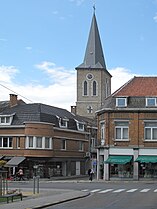Waremme
|
Waremme Borgworm (Dutch) |
||
|---|---|---|
| Municipality | ||
 |
||
|
||
| Country | Belgium | |
| Community | French Community | |
| Region | Wallonia | |
| Province | Liège | |
| Arrondissement | Waremme | |
| Government | ||
| • Mayor | Jacques Chabot | |
| • Governing party/ies | PS | |
| Area | ||
| • Total | 31.04 km2 (11.98 sq mi) | |
| Population (1 January 2016) | ||
| • Total | 14,906 | |
| • Density | 480/km2 (1,200/sq mi) | |
| Postal codes | 4300 | |
| Area codes | 019 | |
| Website | www.waremme.be | |
Waremme (Dutch: Borgworm) is a Walloon municipality located in the province of Liège, in Belgium. The city is located on the River Geer (Dutch: Jeker), in the loessic Hesbaye region. The economy is based on the cultivation of cereals and sugar beet, and on the food industry.
The municipality of Waremme includes the following villages: Bettincourt (Dutch: Bettenhoven), Bleret, Bovenistier, Grand-Axhe, Lantermange, and Oleye (Dutch: Liek).
Several findings were unearthed near Waremme containing remnants of Neolithic and Bronze Age settlements. The main Roman road linking Bavai to Cologne passed right through the territory. Tumuli and Roman villas were found nearby. Romans have also left a horse burial.
The medieval hamlet of Woromia was cited for the first time in 965. On February 5, 1078, Woromia was ceded to the Prince-Bishopric of Liège, together with its castle, five mills, and six breweries.
By 1215, with its 815 inhabitants, it had grown to town size. Its frontier position near the Duchy of Brabant, however, attracted several raids from the duke, causing it to be burnt to the ground and rebuilt at least a couple of times. In the 14th century, the town built a market place and a hospital, slowly becoming an important regional center, where coins were issued and important meetings held.
...
Wikipedia

